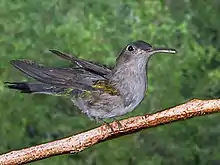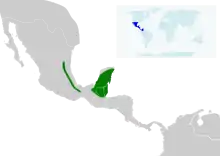Curve-winged sabrewing
The curve-winged sabrewing (Pampa curvipennis) is a species of hummingbird in the family Trochilidae.
| Curve-winged sabrewing | |
|---|---|
 | |
| Pampa curvipennis | |
| Scientific classification | |
| Kingdom: | Animalia |
| Phylum: | Chordata |
| Class: | Aves |
| Order: | Apodiformes |
| Family: | Trochilidae |
| Genus: | Pampa |
| Species: | P. curvipennis |
| Binomial name | |
| Pampa curvipennis (Deppe, 1830) | |
 | |
| Distribution map of Pampa curvipennis (left) | |
Taxonomy
Pampa curvipennis formerly included the wedge-tailed sabrewing (P. pampa) of the Yucatán and the long-tailed sabrewing (P. excellens) of the Isthmus of Tehuantepec under the English name wedge-tailed sabrewing.
This species was formerly placed in the genus Campylopterus. A molecular phylogenetic study published in 2014 found that the genus Campylopterus was polyphyletic.[2] In the revised classification to create monophyletic genera, the curve-winged sabrewing was moved to the resurrected genus Pampa.[3][4]
Description
The curve-winged sabrewing is a large hummingbird with a long, wedge-shaped tail. Upperparts are green with a blue to violet-blue crown that blends into the green nape. It has a white spot behind its eyes and a dark gray cheek. Underparts are pale gray to whitish, often slightly darker laterally. The bill is long and ranges from straight to slightly decurved, and the lower mandible is pinkish at base.[5] The adult male is slightly larger than the female, but other than that sexes are similar.[5] Juveniles are similar to adults but duller in coloring.[5]
Distribution
This species can be found on Mexico's Gulf slope, from within 250 miles of the U.S. border in southern Tamaulipas to northern Oaxaca. It is unrecorded north of Mexico.[5] It is not known to migrate.[5]
Habitat
The wedge-tailed sabrewing resides in humid tropical forests, woodlands, and dense second growth, ranging from near sea level to 4500 feet above sea level. Its natural habitats include tropical and subtropical moist broadleaf forest and heavily degraded former forest.[5]
Behavior
The wedge-tailed sabrewing often forages along walls of vegetation at forest edges and on steep slopes.[5] Its flight style varies from the rapid wingbeats of typical hummingbirds to slower wingbeats like those of swifts. It is bold and curious, and often approaches humans.[5] It breeds from March to July, and its nest is a well-camouflaged cup attached to a horizontal branch.[5]
Vocalization
Calls include steady, persistent chipping and a shrill, nasal peek. The wedge-tailed sabrewing usually sings from dense vegetation, and its songs are complex and variable, usually including insect-like chips, squeaks, and squeals, followed by a series of excited warbled or gurgling notes.[5] Males sing year-round, sometimes in small groups. Some tail or wing movements are associated with perched singing displays.[5]
References
- BirdLife International (2012). "Campylopterus curvipennis". IUCN Red List of Threatened Species. 2012. Retrieved 16 July 2012.
- McGuire, J.; Witt, C.; Remsen, J.V.; Corl, A.; Rabosky, D.; Altshuler, D.; Dudley, R. (2014). "Molecular phylogenetics and the diversification of hummingbirds". Current Biology. 24 (8): 910–916. doi:10.1016/j.cub.2014.03.016.
- Stiles, F.G.; Remsen, J.V. Jr.; Mcguire, J.A. (2017). "The generic classification of the Trochilini (Aves: Trochilidae): Reconciling taxonomy with phylogeny". Zootaxa. 4353 (3): 401–424. doi:10.11646/zootaxa.4353.3.
- Gill, Frank; Donsker, David; Rasmussen, Pamela, eds. (July 2020). "Hummingbirds". IOC World Bird List Version 10.2. International Ornithologists' Union. Retrieved 8 January 2020.
- Williamson, Sheri L. (2001). Hummingbird of North America. New York: Houghton Mifflin Company. ISBN 0-618-02496-4.
